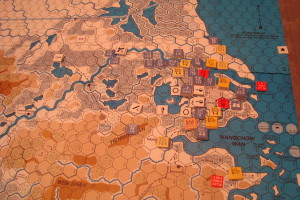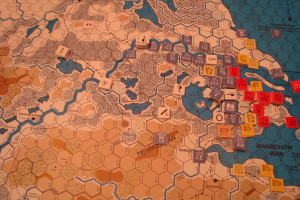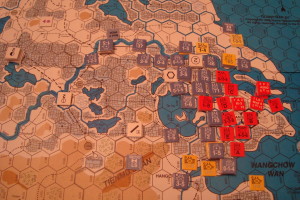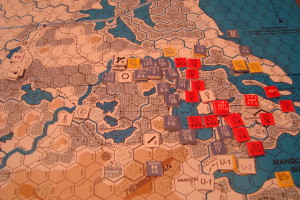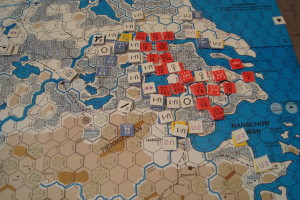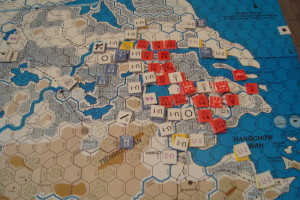Had another War of Resistance (WOR) session with Tim over the weekend. Once again, it was the Fate of Nanking scenario, with Tim as the Japanese commander, and the Chinese committed to a forward defense of Shangai. This scenario starts with an abbreviated August I (1937) turn, and ends with the Jan II (1938) turn. By eschewing strong drink, and limiting our football viewing, we were able to play through the Dec II turn.
I had studied the logistics rules since our last session, and was much more comfortable allocating resource points and moving them from off map to where they could be used. Chinese engineers were kept busy building forts and repairing rail line hits. The limited rail net moved attack points to the theater headquarters, and strategic river movement was employed to augment the supply effort. As a result, I was able spend less time muddling through logistics, and more time on operational challenges.
Tim provided plenty of challenges. He quickly exploited a gap in my river defenses, and established an amphibious beachhead threatening my left flank. As a result, I had to pull back forces dug-in in Shangai, abandon my factories (which can create resource points) and establish a main line of resistance (MLR) in the suburbs. This was an important early move, since the Chinese player’s mission is to delay and defend, and Tim’s landing probably cost me at least one turn.
Tim’s operational problems are to utilize naval transport to move troops from Japan to China, while juggling the problems of limited port capacity and possible damage to his landing craft used for ship to shore movement. Taking advantage of the clear weather, smooth seas, and experience gained in our last session, he rapidly built up his combat power and began a series of attacks supported by strong naval gunfire and aviation assets.
The Chinese Airforce attempted to thwart this naval movement and also shoot down Japanese ground support aircraft. Their efforts were futile, and almost every Chinese air unit was eliminated or aborted.
As the methodical Japanese moved west, they encountered successive defensive lines built by engineers augmented with civillian labor. This increased manpower allows the construction of a fort in one turn. With narrow avenues of advance, and four construction capable units, the Chinese forces enjoyed consistent -1 modifiers when attacked. The Chinese defenders were also aided by flooded rice fields, which halved Japanese attack strength. However, by October, the rice growing season had ended, and the impact of intensely cultivated terrain was much reduced.
Tim was able to consistently create high odds attacks, taking advantage of the inability of the Chinese to mass combat power in any single hex. This is a function of the low strength Chinese divisions, and lack of regimental or brigade troops to augment the combat power of the divisions within stacking rules. In addition, the Chinese player has only four (4) artillery units, which I used to support stacks of unsupported divisions, which otherwise would defend at half strength, rather than augment the stronger, supported, divisions.
This attritional combat took a heavy toll on the Chinese, who are unable to rebuild lost supported divisions during this scenario. I didn’t help matters by failing to feed the lower strength elminiated units back into the fighting.
By November, Tim had split my defense, and established a beachhead on the north side of the Yangtze. He also destroyed my riverine supply capabilities along with their cargo in a devastating aerial attack. As a result, many of the Chinese units were un-supplied for a turn which, fortunately, did not effect their defensive capabilities. However, this slowed the Chinese withdrawal north of the Yangtze. At this point, China’s greatest ally was time. A patchwork defense in depth continued to slow the Japanese advance.
The game came down to a final roll of the dice by Tim to activate his two headquarters during the reaction phase of the Dec II turn. Had he made these rolls (1 or 2, d6), he would have had a chance to break through my last ditch defense of Nanking. Fortunately for the Chinese, this didn’t happen.
We’ll never know what the outcome would have been if the game had been played for one more month to the scenario’s conclusion. Our consensus is that it would have been a toss-up.
Here’s a series of photos to augment my narrative. I’ll hold off on any analysis until Tim forwards his thoughts on the game.
